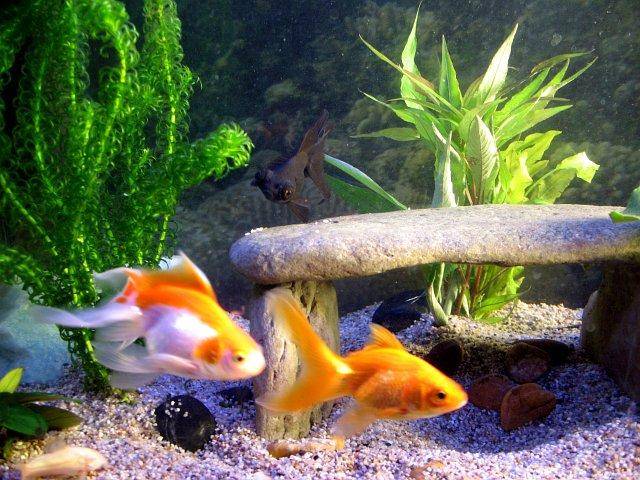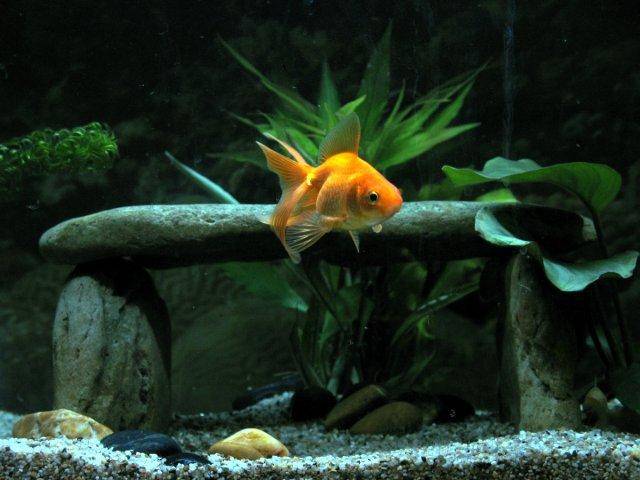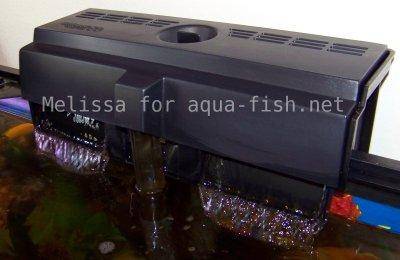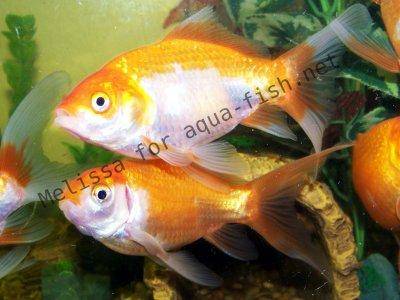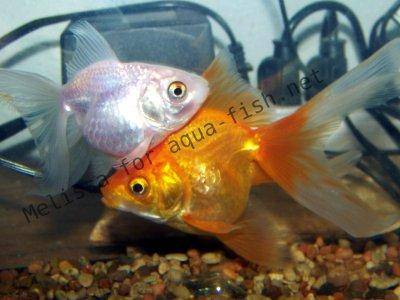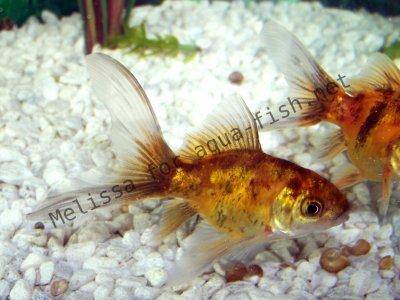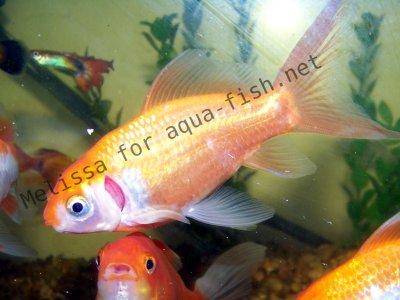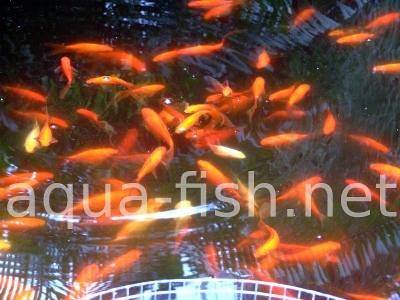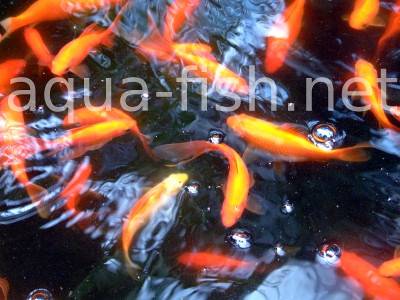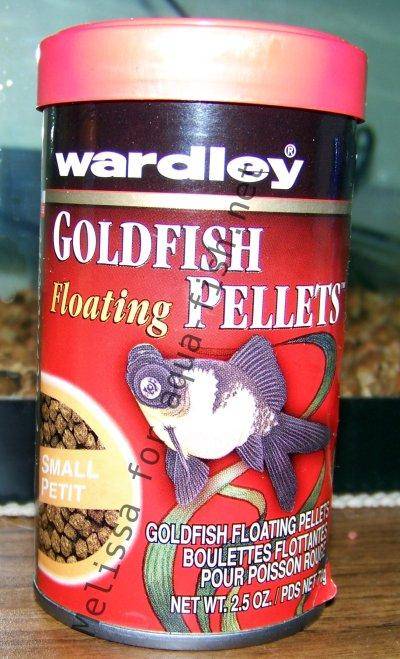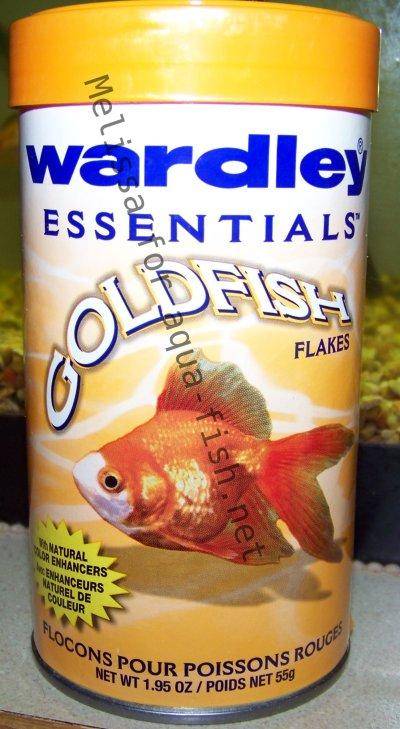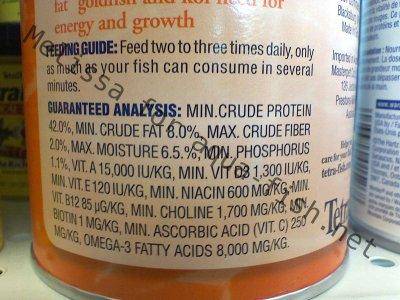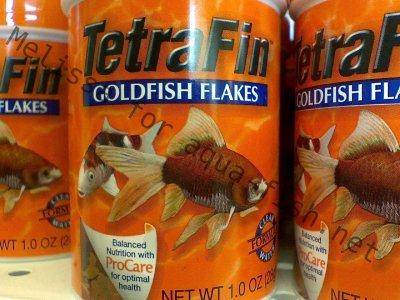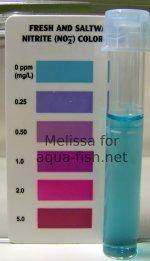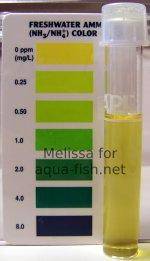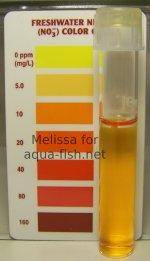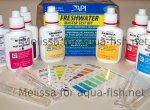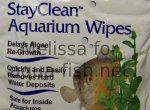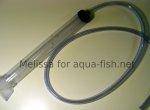Goldfish: A Living Jewel of Aquatics
Quick Links for Goldfish Care
- Goldfish: Origins and Importance
- Different Types of Goldfish
- Selecting and Buying Goldfish
- Aquarium Setup and Care
- Pond-Keeping Essentials
- Diet and Digestion
- Water Quality & Parameters
- Maintenance and Algae Control
- Breeding Goldfish
- Common Diseases & Prevention
- Final Thoughts & Tips
- Frequently Asked Questions
Brief Description
This comprehensive guide to goldfish care covers everything from their origins, types, and selection tips to setting up tanks or ponds, feeding, breeding, disease prevention, and maintenance. Whether you're a beginner or experienced aquarist, this resource will help you keep your goldfish healthy and thriving. Explore different varieties, learn how to ensure high water quality, and find answers to common questions in one place.
🌍 Origins and History
The story of the goldfish (Carassius auratus) begins over a thousand years ago in ancient China. Originally a wild species of carp, these fish were first selectively bred during the Tang dynasty for their unique golden colorations. What began as a modest ornamental tradition in garden ponds quickly flourished into an art form. Over centuries, breeders refined these fish into a dazzling array of colors, body shapes, and fin types. By the 17th century, goldfish had spread across East Asia, and soon after into Europe and beyond. Today, goldfish are among the most widespread and recognizable aquarium species on the planet.
✨ Popularity and Myths
Goldfish are often the first pet fish for many households—and not by accident. Their shimmering scales, hardy nature, and docile temperament make them an ideal choice for beginners. They've been featured in countless children’s books, cartoons, and even folklore. Yet with their popularity come persistent myths: that goldfish thrive in tiny bowls, require no filtration, or that they only live for a few years. In truth, when properly cared for, goldfish can live decades and grow to impressive sizes. Some individuals have lived over 20 years and grown longer than 30 cm (12 inches).
🐠 An Underrated Aquatic Companion
Despite their fame, goldfish are often misunderstood or underestimated. Many view them as disposable, a tragic result of improper care and misinformation. But goldfish are intelligent, interactive, and remarkably resilient fish that deserve the same attention and respect as more exotic species. They recognize their caretakers, exhibit playful behaviors, and bring life and movement to both aquariums and ponds. With the right setup and education, goldfish can become centerpiece animals in any aquatic environment, admired not just for their beauty, but for their personality and legacy.
In this guide, we’ll uncover everything an aquarist should know to raise goldfish with confidence, compassion, and care.
🐡 Types of Goldfish
2.1 Classification by Body Shape
Long-bodied (Single-tail) Varieties – Suitable for Ponds and Aquariums
-
Common Goldfish
The common goldfish is the most traditional and foundational variety of Carassius auratus. Recognized by its torpedo-shaped body and bright orange color, it is considered the hardiest of all goldfish types.
Common goldfish are extremely adaptable and can grow up to 30 cm (12") in aquariums, and even reach over 60 cm (24") in spacious outdoor ponds. With optimal care, they may live up to 30 years. This variety represents the original lineage from which all fancy goldfish were developed through selective breeding.
When selecting a healthy specimen, look for fully developed gill covers and a straight spine. Avoid fish with hunched backs or deformities, which may indicate poor genetics.
-
Comet Goldfish
The comet goldfish is closely related to the common goldfish but features a slender body and longer, flowing fins, especially the caudal (tail) fin. This graceful swimmer is just as resilient as its common counterpart.
Comets can grow up to 55 cm (22") in large ponds and live up to 20 years with proper care. They exhibit a wide range of colors including red, orange, yellow, and white.
When purchasing a comet, ensure the fins are intact and not frayed, as damaged fins may indicate stress or poor health.
-
Shubunkin
Shubunkins are vibrant, single-tailed goldfish known for their striking calico coloration, which includes patches of red, white, black, orange, and rare shades of blue.
Their body and fin shape resemble that of the comet, although some specimens may exhibit double tails. Shubunkins are slightly more delicate but remain hardy and suitable for both aquariums and ponds.
They typically reach 20–30 cm (8–12") in size and live up to 25 years. Their bright colors make them lively, standout additions to any setup.
Fancy (Short-bodied, Double-tail) Varieties – Suitable for Aquariums Only
-
Fantail Goldfish
The fantail goldfish is a classic fancy goldfish recognized by its rounded body, pointed head, and distinctive fan-shaped double tail. It is one of the most beginner-friendly fancy types due to its relatively strong constitution compared to more delicate varieties.
Fantails are available in many color variations, including both metallic and iridescent patterns. While some rare specimens may have telescope eyes, most fantails have normal eyes. They are generally good swimmers for a fancy breed and less prone to buoyancy issues than more extreme body types.
Though they are more robust, fantails can still experience swim bladder disorders if kept in cold water. To reduce this risk, maintain a water temperature above 10 °C (50 °F). With proper care, fantails can grow up to 35 cm (14") and live for up to 12 years, making them a charming and resilient addition to any goldfish aquarium.
-
Veiltail Goldfish
The veiltail goldfish is celebrated for its long, flowing fins and graceful appearance, making it one of the most elegant fancy goldfish varieties. It features a rounded, slightly elongated body and is available in a wide range of color combinations, including both metallic and matte finishes.
The ideal veiltail displays a tall dorsal fin that begins at the highest point of its back, matching the body height for a balanced, symmetrical profile. Due to their exceptionally delicate fins, veiltails require ample open swimming space and minimal obstructions within the aquarium.
They should be housed in tanks with a gentle water flow to avoid fin damage. When kept in optimal conditions, veiltail goldfish can reach up to 25 cm (10") in length and live for up to 16 years, offering both beauty and longevity for experienced keepers who can provide a stable, low-stress environment.
-
Oranda Goldfish
Orandas are one of the most recognizable fancy goldfish, known for their distinctive fleshy head growth, called a "wen", which covers the top and often the sides of the head. These fish have a rounded body, elegant flowing fins, and come in a wide variety of colors, including metallic orange, white, black, blue, and the iconic Redcap Oranda.
The wen begins developing slowly, sometimes appearing as white spots in juveniles before maturing into a full head growth. Ideal specimens display a balanced wen that does not obstruct the fish’s vision, along with long, well-formed fins.
Orandas require clean, well-oxygenated water to prevent infections around the wen and ensure overall health. When well cared for, they can live up to 25 years and reach 25 cm (10") in length, making them both a striking and long-lived addition to any fancy goldfish aquarium.
-
Ranchu Goldfish
The Ranchu is a distinguished fancy goldfish breed, often regarded as the “king of goldfish” in Japan. Characterized by its lack of a dorsal fin and a deeply arched back, the Ranchu has a rounded, egg-shaped body and a soft, fleshy head growth (wen).
Compared to the Lionhead goldfish, the Ranchu typically has a smoother back curvature and a less prominent hood. Ideal specimens exhibit a gentle 90° curve from head to tail with no noticeable humps.
These fish are slow and deliberate swimmers, and their body structure makes them vulnerable to injury or competition in mixed tanks. They require stable water temperatures and should be kept in aquariums rather than outdoor ponds, as they are sensitive to cold. Ranchus can grow up to 20 cm (8") and, with proper care, may live up to 15 years.
-
Ryukin Goldfish
The Ryukin is a fancy goldfish known for its distinctive high-shouldered back that creates a steep arch just behind the head. It has a short, deep body and a pointed head, giving it a powerful, compact appearance.
Ryukins come in a wide range of colors including red, white, calico, and metallic hues, with the red-and-silver combination being especially popular among aquarists. Their long, flowing double tails classify them as fancy goldfish, though they retain normal eyes.
Reaching up to 25 cm (10") in length, the Ryukin is considered one of the more robust and hardy fancy varieties. With proper care, Ryukins can live for 20 to 25 years, and their vibrant coloration and commanding body shape make them a striking presence in any aquarium.
-
Telescope Eye Goldfish
Also known as the Dragon Eye Goldfish, this variety is instantly recognizable by its large, protruding eyes that extend outward from either side of the head. These fish have high dorsal fins and rounded, short bodies.
Despite their unusual appearance, Telescope Eyes are relatively hardy and can live up to 25 years. They typically grow to around 20 cm (8"). They come in a wide range of colors, sometimes with eye colors contrasting the body.
Because of their limited vision, Telescope Eye goldfish should be kept in tanks free of sharp decorations and aggressive tankmates. They thrive in stable environments with gentle water flow and good lighting to help them navigate safely.
-
Celestial Goldfish
Celestial goldfish are known for their upward-pointing, telescope-like eyes, giving the impression that they are always gazing at the stars. These delicate fancy goldfish have elongated bodies, round bellies, and a double tail, but notably lack a dorsal fin.
They are most commonly seen in deep orange colors. A high-quality Celestial has symmetrical eyes in both size and angle. A special variant called the Celestial Pompon adds nasal flaps (pompons) to their unique look.
Due to their poor swimming ability and sensitivity, Celestials are best kept in species-only tanks or with similarly gentle companions. They typically live about 7 years and grow up to 25 cm (10").
-
Lionhead Goldfish
This distinctive fancy goldfish is named for its lion-like head growth (wen), which becomes increasingly prominent with maturity. The hood covers the entire head except for the eyes, and is generally more developed than in Ranchus or Orandas.
Lionheads have a rounded belly, double tail fin, and no dorsal fin, giving them a smooth-backed profile. Compared to Ranchus, they have a slightly longer, more elongated body with a straight back. They require pristine water conditions to avoid infections of the wen. With good care, they can grow up to 20 cm (8") and live up to 15 years.
These fish are best suited for calm, obstacle-free aquariums and are admired for their regal look and gentle swimming behavior.
-
Bubble Eye Goldfish
This unique fancy goldfish is instantly recognizable thanks to its fluid-filled sacs beneath the eyes. Bubble Eyes have a round, elongated body, no dorsal fin, and a double tail.
Ideal specimens have symmetrical eye sacs matching the length of the body. These sacs are very delicate and prone to damage, so they should be kept in peaceful aquariums with gentle tankmates and soft décor. Damaged sacs may heal in pristine water with low stress.
They grow up to 15 cm (6") and live up to 10 years. Their unusual and charming appearance makes them popular among dedicated fancy goldfish lovers.
-
Pearlscale Goldfish
Pearlscales are easily recognized by their dome-like, pearl-like scales, which are thickened and raised for a bead-like appearance. This variety has an exaggeratedly round body, short fins, and a double caudal tail.
They are poor swimmers and more sensitive than other goldfish. Gentle filtration and calm tankmates are necessary. Despite their fragility, they can grow to 20 cm (8") and live up to 20 years with excellent care.
Their shimmering, jewel-like appearance makes them a treasured addition for aquarists who value delicate aquatic beauty.
-
Pompon Goldfish
This rare and ornamental variety is easily recognized by its distinctive nasal outgrowths, known as “pompons,” located just above the mouth. These fleshy growths resemble decorative tufts and are typically symmetrical on both sides of the face.
The most coveted variety is the Red Magpie, which features bright orange pompons contrasted by a darker-colored face. Ideal specimens have balanced pompons and smooth, rounded bodies. As slow swimmers without dorsal fins, they require calm tanks with soft décor. With excellent care, they can reach 20 cm (8") and live up to 25 years.
-
Wakin Goldfish
Often referred to as the “double tail common goldfish”, the Wakin combines the hardiness of the Common Goldfish with a distinct double tail. The caudal fins are compact and symmetrical, unlike the flowing tails of veiltails or butterflies.
Wakins come in vivid colors such as orange, red-and-white, and calico. Their sturdy build makes them suitable for both aquariums and ponds. With proper care, they grow to 25–30 cm (10–12") and live over 20 years, combining durability with elegance.
-
Jikins Goldfish
Also known as the “butterfly tail goldfish”, the Jikins boasts a streamlined body and striking butterfly-like caudal fin, where the tail lobes flare outward when viewed from above—its most distinguishing feature.
True Jikins are rare, especially prized in Japan. The ideal color pattern is white with red lips, fins, and tail—known as “red-and-white”. They thrive in spacious aquariums or ponds with gentle currents and can live up to 15–20 years, reaching lengths of 8–10 inches.
-
Nymph Goldfish
The Nymph is a rare and lesser-known variety that bridges the gap between fancy and single-tailed goldfish. It shares the rounded body shape and coloration of Fantails and Veiltails but has single anal and caudal fins, giving it the look of a compact common goldfish.
Nymphs often arise from crossbreeding between fancy types and are more agile and robust than their ornamental relatives. They can grow up to 14 inches and live around 12 years. Their blend of strength and subtle elegance makes them ideal for aquarists who admire fancy forms but want a hardy, low-maintenance fish.
-
Moor Goldfish
The Moor is a variety of telescope eye goldfish prized for its rounded body, flowing fins, and velvety appearance. The most popular form is the Black Moor, known for its deep black coloration, which may include bronze highlights under certain lighting.
Due to limited vision and slower swimming ability, Moors thrive best in peaceful aquariums without aggressive or fast-moving tank mates. They're not suited for ponds with fluctuating temperatures or high competition. With proper care, they can live up to 25 years and grow as large as 10 inches.
2.2 Comparison of Goldfish Types
- Size: Long-bodied types (up to 30 cm or 12") grow larger than fancy types (often 10–15 cm or 4–6").
- Hardiness: Common, Comet, and Shubunkin are very hardy and tolerant of wider temperature ranges.
- Difficulty: Fancy types require more care—stable temperatures, gentle filtration, and soft substrate.
- Swim Bladder Issues: Fancy goldfish are prone to buoyancy disorders due to their compact, round body shapes. Feeding easily digestible food and avoiding overfeeding helps reduce the risk.
🛒 Choosing and Buying a Goldfish
🩺🐟 How to Choose a Healthy Specimen
When selecting a goldfish, careful observation is essential. Look for the following traits that indicate a healthy fish:
- Clear Eyes: The eyes should be symmetrical, clear, and not bulging unevenly (except in varieties like Telescope or Celestial).
- Intact Fins: Avoid fish with torn, clamped, or frayed fins. The fins should be spread naturally and free of rot or white edges.
- Smooth Swimming: The fish should swim upright without wobbling, floating sideways, or struggling to maintain balance.
- Full Gill Covers: Both gill plates should fully cover the gills, with no signs of deformation or exposure.
- Bright Coloration: Healthy goldfish typically display vibrant, even coloration and show interest in their surroundings.
Compatibility Tip: Avoid mixing fast-swimming varieties like Comet Goldfish with delicate, slow-moving types such as Pearlscales. The more active fish may outcompete the slower ones for food and cause stress or injury. Always consider the swimming speed, temperament, and body structure of your goldfish when choosing tankmates.
🧼🏪 The Importance of Store Hygiene
A healthy goldfish is often a reflection of the store’s hygiene standards. Before making a purchase, inspect the tank conditions:
- Are the tanks clean, with clear water and working filters?
- Are any of the fish lethargic, gasping at the surface, or showing signs of illness?
- Is uneaten food or waste accumulating in the substrate?
- Are multiple dead or diseased fish visible in any tank?
If the store shows signs of neglect or poor maintenance, it’s best to find another supplier. A healthy start is the key to long-term success.
🎯🐟🚫 Inappropriate Practices: Goldfish as Prizes
Despite their popularity, goldfish are too often subjected to mistreatment through outdated and unethical practices. One such example is using goldfish as prizes at fairs or carnivals.
These fish are usually kept in cramped containers, without proper filtration or aeration, and are handed out to individuals unprepared for their care. This not only leads to suffering and early death for the fish, but also spreads misinformation about their needs and value.
Goldfish are living creatures, not toys or trophies. They deserve responsible handling, knowledgeable care, and proper environments from the very beginning.
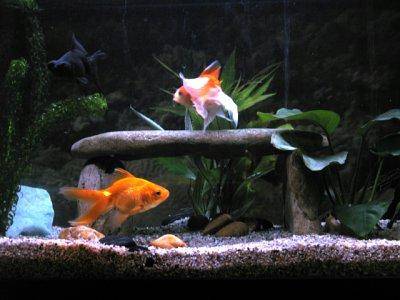

🏠 Goldfish in Aquariums
📏🏗️🐟 4.1 Tank Size and Layout
Before purchasing any equipment, it's wise to take a moment and visualize your ideal goldfish aquarium. Would you prefer a clean, minimalist design with a few elegant fish, or a vibrant aquascape with plants and decorative features? Will it house one or two fancy goldfish, or a lively group of long-bodied swimmers?
Goldfish may start small, but they grow quickly and live long lives. It's essential to match your vision with the right tank size, layout, and stocking plan, ensuring your aquatic setup remains both beautiful and functional for years to come.
Inspection before water filling is essential: A small crack or poorly sealed edge can become a disaster once the tank is full. Always inspect the glass and seams carefully before adding any water. What begins as enthusiasm for aquascaping should not end with 100 liters on the floor and a panic in the household!
- Minimum Volume: Plan for at least 15–30 liters (4–8 US gallons) of water per fish. More is always better to maintain stable water quality and reduce stress.
- Substrate and Decorations: Use smooth gravel or carefully selected coarse sand that goldfish can sift through safely. Avoid sharp edges that could injure their mouths. Very fine sand is not recommended as it may clump, trap harmful substances, and promote anaerobic zones. Decorations should be rounded and safe for long-finned varieties. Artificial or natural driftwood, as well as smooth stones, are good options.
Backgrounds can greatly enhance the appearance of your aquarium. A black or dark background creates a strong visual contrast that emphasizes the vivid colors of goldfish. For example, a Red Cap Oranda stands out beautifully against a black backdrop. Choose a background that complements your fish without adding visual clutter—solid colors are often best.
- Plants: Choose sturdy species like Anubias, Java Fern, or plastic/silk plants. Goldfish tend to uproot or eat soft plants.
Java Moss is another excellent option, especially for those seeking low-growing plants that won’t obstruct swimming space. It is easy to maintain, doesn’t require substrate planting, and can be attached to rocks or driftwood. In addition to its decorative role, Java Moss also helps absorb excess nitrates, contributing to better water quality.
- Lighting: Standard aquarium lighting is sufficient; goldfish do not require intense light. A natural day-night cycle helps regulate their behavior and health.
Lighting and genetics work hand in hand: The full splendor of a goldfish’s color is encoded in its genes, but it takes proper light and nutrition to bring that potential to life. Think of light as the sunlight of progress—without it, even the most promising traits remain hidden in the shadows.
- Temperature: Goldfish are coldwater fish. Maintain water between 20–24 °C (68–75 °F). Heaters are not required unless the room temperature drops too low. In warmer climates or during heatwaves, aquarium chillers can help keep the water within a safe range. Stable temperature improves comfort and reduces the risk of temperature-related stress.
🌀💨⚙️ 4.2 Filtration and Oxygenation
Goldfish are messy eaters and produce a large amount of waste. Efficient filtration and good oxygenation are therefore critical to their health and longevity.
🔄 Nitrogen Cycling (Fishless)
Before adding any fish, your aquarium must undergo the nitrogen cycle, a process where beneficial bacteria colonize the filter and substrate to convert toxic waste into less harmful substances. The most humane and effective method is fishless cycling, which does not expose live fish to ammonia or nitrite toxicity.
To start fishless cycling:
- Add a measured dose of pure ammonia to mimic fish waste. Ammonia should reach about 2–4 ppm.
- Allow time for bacteria to convert ammonia into nitrite, and then into nitrate.
- This process can take 3–6 weeks, depending on temperature and bacterial growth rates.
- You may use commercial bacterial starters to speed things up.
Use a liquid test kit to track progress. The cycle is complete when:
- Ammonia = 0 ppm
- Nitrite = 0 ppm
- Nitrate = present (10–40 ppm)
Only after these levels are reached should goldfish be introduced. This crucial step ensures your fish enter a safe, biologically stable environment—protecting them from harm and promoting long-term health.
Types of Filtration:
- Mechanical Filtration: Removes uneaten food, solid waste, and debris. Keeps the water visibly clean.
- Biological Filtration: Uses beneficial bacteria to break down toxic substances like ammonia and nitrites into less harmful nitrates.
- Chemical Filtration: Often includes activated carbon to remove odors and impurities. Not strictly necessary if regular water changes are performed, but it can help in emergencies or after medication use.
Recommended Filter Types:
- Canister Filters: Highly efficient, suitable for larger tanks, and capable of handling high bio-loads from goldfish.
- Power Filters (HOB – Hang-On-Back): Easy to install and maintain. Choose one rated for a tank larger than your own for best results.
Undergravel Filters: Not recommended for goldfish tanks. They clog easily and don't provide enough filtration for the amount of waste goldfish generate.
Ensure strong surface agitation or use air stones to promote gas exchange. Goldfish require well-oxygenated water, especially in warmer temperatures or when stocking is dense.
🌳 Goldfish in Garden Ponds
While many goldfish varieties thrive indoors, only the hardiest types are truly suited for life in outdoor ponds. With the right planning and care, a garden pond can become a beautiful, natural habitat for your fish.
Suitable Varieties for Ponds
Only single-tailed (long-bodied) goldfish such as:
- Common Goldfish
- Comet Goldfish
- Shubunkin
...should be kept in ponds. These varieties are strong swimmers, hardy against temperature fluctuations, and less prone to disease than fancy types. Fancy goldfish with rounded bodies and long fins are too delicate for the outdoor environment.
Overwintering and Feeding
- Cold Tolerance: These goldfish can survive temperatures close to freezing, but the pond must be deep enough (at least 80 cm / 30 inches) to prevent complete freezing.
- Feeding in Cold Weather: When water temperature drops below 10 °C (50 °F), goldfish metabolism slows down. Stop feeding completely below this threshold to prevent digestive issues.
- Winter Prep: Consider using a floating de-icer or air stone to keep a hole in the ice for gas exchange during harsh winters.
⚠️🐾❄️🌊 Risks to Consider
- Strong Water Currents: Avoid strong fountains or water jets, as goldfish have sensitive swim bladders that can be damaged by turbulent water.
- Predators: Raccoons, herons, and cats may pose a threat. Protect your pond with netting or hiding places like ceramic pots and submerged caves.
- Freezing: In cold climates, a shallow pond can freeze solid. This is fatal to the fish. Ensure sufficient depth and avoid completely still, stagnant water.
With proper setup and care, goldfish can thrive in a pond for decades, growing to their full potential and living in harmony with nature. A well-maintained pond is not only a home for goldfish—it is a symbol of balance between human hands and the aquatic world.
🍽️ Feeding and Digestion
Goldfish are omnivorous creatures with a big appetite and no stomach. Their diet and digestive process are key not only to their health but also to water cleanliness and overall tank balance.
What to Feed
A balanced diet for goldfish includes:
- Pellets and granules: Opt for sinking or slow-sinking varieties designed specifically for goldfish. These are easier to digest and less likely to pollute the water than flakes.
- Vegetables: Blanched peas (deshelled), spinach, lettuce, zucchini, and cucumber slices are excellent additions.
- Live and frozen foods: Brine shrimp, daphnia, bloodworms, and tubifex worms provide protein and variety.
What to Avoid
Some commonly offered foods are actually harmful to goldfish:
- Bread and biscuits: These ferment in the digestive tract, leading to bloating and swim bladder issues.
- Flakes: Often low in nutrition and high in fillers, flakes can swell in water and cause digestive problems.
- Overfeeding: Excess food rots, pollutes the water, and harms the nitrogen cycle.
The Importance of Fasting
One fasting day per week helps goldfish clear their digestive systems, especially in indoor aquariums. This practice mimics natural feeding rhythms and helps prevent swim bladder disorders.
Digestion Without a Stomach
Goldfish do not have stomachs. Food passes rapidly through their intestines, so nutrients must be absorbed quickly. This means:
- More waste is produced, contributing to water pollution if not managed with good filtration and feeding practices.
- High-fiber and easy-to-digest foods reduce the risk of constipation and internal gas buildup.
Proper feeding is essential not just for the fish—but for the entire ecosystem of the aquarium or pond. A well-fed goldfish is not an overfed goldfish!
💧 Water Quality and Maintenance
Clean water is the foundation of a healthy life for your goldfish. Regular monitoring and maintenance are crucial to prevent disease, ensure proper digestion, and support overall well-being.
💧📏🔬🌡️ Key Water Parameters
- pH: Between 6.0 and 8.0. Goldfish are adaptable but prefer stable conditions.
- Water hardness (dGH): From 4 to 18 degrees of general hardness. Medium hardness is ideal.
- Temperature: Optimal range is 18–24 °C (64–75 °F). Sudden changes should be avoided.
🔄💦🧽📆 Regular Water Changes
Goldfish produce a significant amount of waste. To keep the water clean:
- Perform partial water changes once per week – about 20–30% of the tank’s volume.
- Always use a water conditioner when replacing tap water to neutralize chlorine and heavy metals.
- Never do full water changes unless absolutely necessary, as this disrupts beneficial bacteria colonies.
Water Testing
Routine testing helps identify problems before they affect your fish. Test the following at least once per week:
- Ammonia (NH3): Should always be 0 ppm. Even small amounts are toxic.
- Nitrite (NO2−): Also must be 0 ppm. It interferes with oxygen transport in the blood.
- Nitrate (NO3−): Should be < 40 ppm, preferably below 20 ppm.
- pH: To monitor shifts that may indicate pollution or buffering issues.
Use a reliable liquid test kit rather than test strips for more accurate results. Keeping a logbook of water values can help you detect trends and prevent long-term issues.
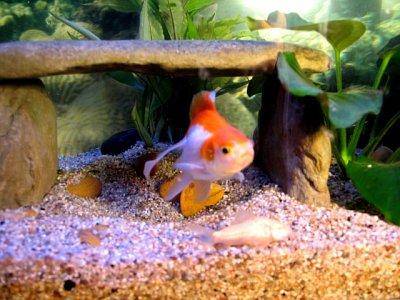
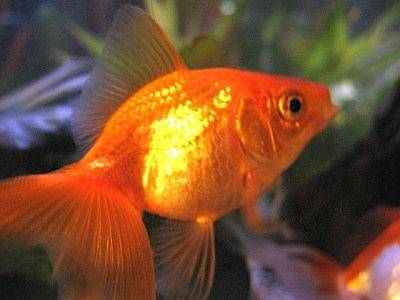
🛠️🧼🐟🧹 Maintenance Practices
Maintaining a clean aquarium is not just about aesthetics—it’s vital for the health of your goldfish and the stability of the ecosystem. Regular upkeep prevents the buildup of waste, deters algae, and keeps your filtration system running efficiently.
Gravel Vacuuming and Glass Cleaning
- Gravel vacuuming (siphoning): Remove detritus and uneaten food from the substrate during weekly water changes. This helps reduce ammonia spikes and keeps the tank bottom clean.
- Glass cleaning: Use magnetic scrapers or algae pads to remove algae from the glass without wetting your hands. Avoid metal tools that could scratch the glass.
Algae Control
Goldfish tanks are especially prone to algae due to their nutrient-rich water. Keep algae under control with these steps:
- Limit the tank’s exposure to direct sunlight.
- Reduce lighting duration to 6–8 hours daily, or use a timer.
- Perform regular water changes to keep nitrate levels low.
- Use algae scrubbers, wipes, or UV sterilizers if algae becomes persistent.
Conditioners and Additives
- Water conditioners: Always treat tap water to neutralize chlorine, chloramine, and heavy metals before adding it to the tank.
- Stress coat additives: Products with aloe vera or similar ingredients help soothe fish during water changes and transport.
- Algae-control products: Use only when necessary, and in moderation. Avoid overuse, which may harm beneficial bacteria.
Consistency is key. Establishing a weekly routine will go a long way in preventing algae blooms, water quality crashes, and fish stress. Think of your maintenance routine as an essential responsibility—one that ensures the long-term health and balance of your aquatic environment.
🐣🐟❤️🌱 Breeding Goldfish
8.1 Sexing and Pre-Spawning Preparation
Determining the sex of goldfish becomes easier as they mature. Males often develop small white bumps called tubercles on their gill covers and the leading edges of their pectoral fins. Females typically exhibit a swollen belly when carrying eggs.
- Group selection: Choose a group of 5–6 young, healthy fish to increase the likelihood of having both sexes.
- Pre-spawning routine: Gradually lower the water temperature during winter months and reduce feeding to mimic natural seasonal changes.
- Conditioning: Begin feeding high-protein foods in early spring to trigger spawning behavior.
8.2 Spawning in an Aquarium
Spawning usually begins at dawn and can last several hours. To encourage breeding:
- Use spawning media: Add fine-leaved plants, synthetic spawning mops, or even a piece of netting or pantyhose as egg-catching surfaces.
- Maintain water temperature at around 20 °C (68 °F).
- Pairing: Place one female with two active males in the spawning tank during the evening. Spawning may occur the next morning or within a few days.
- Remove the adults immediately after spawning to prevent them from eating the eggs.
8.3 Hatching and Raising Fry
Fertilized eggs turn clear with visible black dots (eyes of fry) after 1–2 days. Unfertilized or fungus-infected eggs turn white and should be removed if possible.
- Hatching time: At 20 °C, eggs hatch in about 4 days.
- Feeding the fry: During their first two days, fry survive on their yolk sacs. Once free-swimming, feed them with infusoria, baby brine shrimp, or other microscopic food.
- Growth stages: After 2–3 weeks, gradually transition to finely crushed adult food or specialized fry food.
- Culling: Some fry may develop deformities. For the health of the group, selective removal (culling) may be necessary.
Proper preparation and attentive care significantly increase the survival rate of fry and promote the development of strong, healthy goldfish. While the breeding process requires patience and diligence, it offers a deeply rewarding experience—watching new life emerge and grow under your guidance is one of the greatest joys in aquaristics.
🩺 Common Diseases in Goldfish
Goldfish are generally hardy and resilient, but they are still susceptible to illness—especially when water quality, diet, or overall care are neglected. Early detection of symptoms and consistent tank maintenance are critical for preventing diseases and ensuring a healthy aquatic environment.
Swim Bladder Disorder
This is one of the most common problems in fancy goldfish, caused mainly by overfeeding, low-quality food, or gulping air while feeding at the surface. Symptoms include:
- Difficulty maintaining buoyancy
- Floating upside-down or sinking to the bottom
- Erratic swimming or spinning
Prevention: Feed sinking pellets or pre-soaked food, incorporate vegetable matter like peas, and observe one fasting day per week.
Other Common Ailments
- Popeye: Bulging eyes caused by infection or poor water conditions. May require antibacterial treatment.
- Ich (White Spot Disease): Caused by a protozoan parasite, appears as tiny white dots on fins and body. Treat with elevated temperatures and anti-parasitic medication.
- Fin Rot: Characterized by ragged or decaying fins, often linked to poor water quality and bacterial infections.
Preventing Disease the Smart Way
To ensure your goldfish stay healthy and stress-free:
- Maintain high water quality: Regular water changes, proper filtration, and avoiding overfeeding are essential.
- Practice good hygiene: Clean the tank regularly, remove uneaten food, and vacuum the substrate.
- Quarantine new fish: Always isolate newcomers for at least 2–4 weeks to monitor for signs of disease before introducing them to the main tank.
With proper care, most goldfish illnesses are preventable. Healthy fish are happy fish—and maintaining their well-being ensures a thriving and harmonious aquatic environment for years to come. If your goldfish appears unwell, don't delay—test the water and isolate the fish if needed. Early action saves lives.
📘 Conclusion and Practical Advice
Goldfish are not merely starter pets—they are long-term companions capable of bringing joy, serenity, and vibrant beauty to any aquarium or pond. With proper care and attention, these resilient fish can thrive and live for many years.
Who Should Keep Goldfish?
Goldfish are ideal for:
- Families with children, as a gateway into responsible pet ownership
- Beginner aquarists ready to commit to proper setup and care
- Experienced hobbyists seeking to explore different varieties or pond keeping
Myths vs. Reality
- Myth: Goldfish can live in a bowl without filtration.
Reality: This leads to stunted growth, poor health, and early death. Goldfish need large, filtered environments. - Myth: Goldfish only live a couple of years.
Reality: With proper care, goldfish commonly live 10–20 years, and some reach 30 years. - Myth: Goldfish are boring.
Reality: They are intelligent, curious, and capable of recognizing their caretaker. They interact, explore, and even "beg" for food!
Social Behavior
Goldfish are peaceful and thrive in the company of their kind. Some varieties, especially long-bodied types, can cohabitate with other peaceful coldwater species of similar size. However, fancy types should be kept with similar-bodied goldfish to avoid competition and stress.
Explore More
For more information, check out these helpful resources:
❓ FAQ – Frequently Asked Questions
How many liters does one goldfish need?
One goldfish requires a minimum of 15 to 30 liters (4–8 gallons) of water, depending on its variety. Fancy goldfish need more space due to their size and waste production. Larger tanks also help maintain stable water quality.
Why is my goldfish breathing rapidly?
Rapid breathing is often a sign of low oxygen levels, poor water quality, or ammonia/nitrite poisoning. Check your filter, test the water parameters, and perform a partial water change. Make sure the tank is not overcrowded or overheated.
When do goldfish reach sexual maturity?
Goldfish typically reach sexual maturity at around 1 year of age, but breeding success increases when fish are 2 to 3 years old. Maturity is influenced by environmental factors such as temperature and diet.
What fish are compatible with goldfish?
Goldfish can live peacefully with other coldwater, slow-moving, and similarly-sized fish. Examples include white cloud mountain minnows, dojo loaches, or other goldfish of similar body type. Avoid tropical fish or nippy species like barbs or tetras.
How can I tell if a goldfish is pregnant?
Goldfish do not get pregnant in the traditional sense as they are egg layers. However, a gravid female will develop a visibly rounded, swollen abdomen. You may also observe males chasing her during spawning periods. A fuller vent near the anal fin may also indicate readiness to spawn.
Do goldfish sleep?
Yes, goldfish rest at night and become less active. They don’t have eyelids but seek darker, quieter places to rest.
